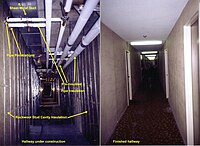
Photo from wikipedia
Fluid resonant oscillations have been reported for corrugated pipes installed in offshore gas and oil fields. Corrugated pipes can be modelled as a series of consecutive shallow cavities. The current… Click to show full abstract
Fluid resonant oscillations have been reported for corrugated pipes installed in offshore gas and oil fields. Corrugated pipes can be modelled as a series of consecutive shallow cavities. The current study investigates the development of the individual cavity source along multiple-cavity arrangements and whether this source eventually reaches a fully developed form with a persistent source contribution. Such a contribution defines a proposed building unit cavity source. To achieve this objective, the aeroacoustic source of a test section with a gradually increasing number of cavities is measured by means of the standing wave method. The individual cavity source is found to asymptotically reach a constant value starting from the fourth cavity. This source value is a function of the excitation level and eventually decays at a high excitation level of 10%. The measured building unit source is validated by two different approaches. First, a prediction model is developed for a twelve-cavity configuration based on the building unit source. Fair agreement is found between the predicted and the experimentally measured pressure amplitudes. The second validation approach involves extracting the source of the ninth cavity in a twelve-cavity configuration using Howe’s analogy based on particle image velocimetry measurements. The ninth cavity source fairly matches the building unit source for excitation levels higher than 1%. For lower excitation levels, three-dimensional flow effects are found to become more dominant and lead to larger discrepancies with the unit source.
Journal Title: Physics of Fluids
Year Published: 2018
Link to full text (if available)
Share on Social Media: Sign Up to like & get
recommendations!